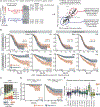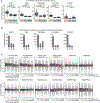Nuclear speckles regulate functional programs in cancer
- PMID: 39747580
- PMCID: PMC12039181
- DOI: 10.1038/s41556-024-01570-0
Nuclear speckles regulate functional programs in cancer
Abstract
Nuclear speckles are dynamic nuclear bodies characterized by high concentrations of factors involved in RNA production. Although the contents of speckles suggest multifaceted roles in gene regulation, their biological functions are unclear. Here we investigate speckle variation in human cancer, finding two main signatures. One speckle signature was similar to healthy adjacent tissues, whereas the other was dissimilar, and considered an aberrant cancer speckle state. Aberrant speckles show altered positioning within the nucleus, higher levels of the TREX RNA export complex and correlate with poorer patient outcomes in clear cell renal cell carcinoma (ccRCC), a cancer typified by hyperactivation of the HIF-2α transcription factor. We demonstrate that HIF-2α promotes physical association of certain target genes with speckles depending on HIF-2α protein speckle-targeting motifs, defined in this study. We identify homologous speckle-targeting motifs within many transcription factors, suggesting that DNA-speckle targeting may be a general gene regulatory mechanism. Integrating functional, genomic and imaging studies, we show that HIF-2α gene regulatory programs are impacted by speckle state and by abrogation of HIF-2α-driven speckle targeting. These findings suggest that, in ccRCC, a key biological function of nuclear speckles is to modulate expression of select HIF-2α-regulated target genes that, in turn, influence patient outcomes. Beyond ccRCC, tumour speckle states broadly correlate with altered functional pathways and expression of speckle-associated gene neighbourhoods, exposing a general link between nuclear speckles and gene expression dysregulation in human cancer.
© 2025. The Author(s), under exclusive licence to Springer Nature Limited.
Conflict of interest statement
Competing interests: A.R. receives royalties from LGC/Biosearch Technologies related to Stellaris RNA-FISH. The other authors declare no competing interests.
Figures















References
-
- Lamond AI & Spector DL. Nuclear speckles: a model for nuclear organelles. Nat. Rev. Mol. Cell Biol. 4, 605–612 (2003). - PubMed
MeSH terms
Substances
Grants and funding
- R35 CA263922/CA/NCI NIH HHS/United States
- R35 CA220483/CA/NCI NIH HHS/United States
- R35CA220483/U.S. Department of Health & Human Services | NIH | National Cancer Institute (NCI)
- R35CA263922/U.S. Department of Health & Human Services | NIH | National Cancer Institute (NCI)
- P30 CA045508/CA/NCI NIH HHS/United States
- F32 CA221010/CA/NCI NIH HHS/United States
- RO1CA078831/U.S. Department of Health & Human Services | NIH | National Cancer Institute (NCI)
- W81XWH-20-1-0856/U.S. Department of Defense (United States Department of Defense)
- F32CA221010/U.S. Department of Health & Human Services | NIH | National Cancer Institute (NCI)
- R01 CA078831/CA/NCI NIH HHS/United States
LinkOut - more resources
Full Text Sources
Medical
Molecular Biology Databases

